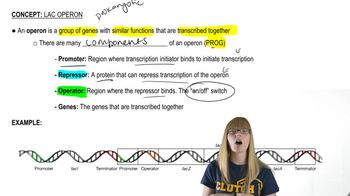Here are the essential concepts you must grasp in order to answer the question correctly.
Lac Operon
The lac operon is a set of genes in bacteria that are involved in the metabolism of lactose. It includes genes for β-galactosidase, which breaks down lactose into glucose and galactose, and permease, which facilitates lactose entry into the cell. The operon is regulated by the presence or absence of lactose, allowing bacteria to efficiently use lactose as an energy source when available.
Recommended video:
Gene Regulation
Gene regulation refers to the mechanisms that control the expression of genes, determining when and how much of a gene product is made. In the context of the lac operon, regulation is achieved through the binding of repressor proteins and the presence of inducers like lactose, which can activate or deactivate the operon. Loss of regulation can lead to continuous expression of the operon, regardless of lactose availability.
Recommended video:
Mutations and Genetic Events
Mutations are changes in the DNA sequence that can affect gene function and regulation. In the case of the Lactobacillus subspecies, genetic events such as point mutations, deletions, or insertions in the regulatory regions of the lac operon could lead to a loss of regulation. These mutations may result in the operon being constitutively active (always 'on') or inactive, impacting the organism's ability to metabolize lactose effectively.
Recommended video:
 Verified step by step guidance
Verified step by step guidance


